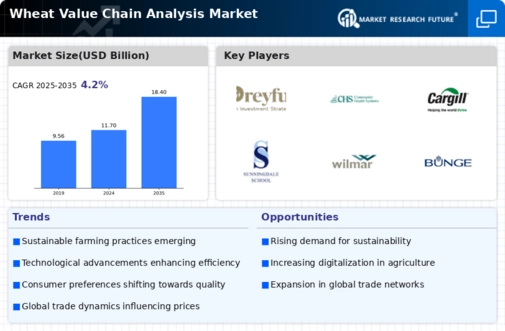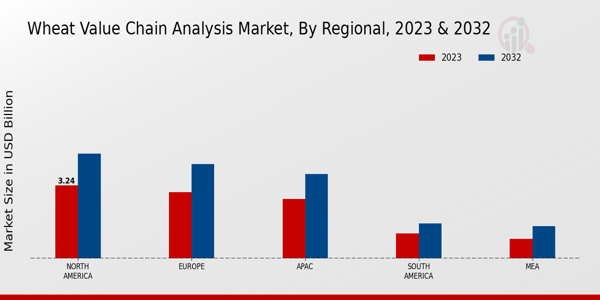Increasing Global Population
The Global Wheat Value Chain Analysis Market Industry experiences a significant driver from the increasing global population, projected to reach approximately 9.7 billion by 2050. This demographic trend necessitates a corresponding rise in food production, particularly wheat, which is a staple food for a large portion of the world's population. As demand escalates, the industry is expected to grow, with the market value reaching 11.7 USD Billion in 2024. This growth reflects the urgent need for efficient wheat production and distribution systems to meet the nutritional requirements of a burgeoning population.
Market Trends and Projections
Government Policies and Support
Government policies and support mechanisms significantly influence the Global Wheat Value Chain Analysis Market Industry. Many countries implement subsidies, tariffs, and trade agreements to stabilize wheat prices and encourage domestic production. For example, initiatives aimed at enhancing agricultural productivity through funding and research can lead to increased wheat output. Such policies not only support farmers but also ensure a steady supply of wheat to meet the growing global demand. As a result, the industry is likely to benefit from favorable regulatory environments that promote sustainable wheat production.
Rising Demand for Wheat-Based Products
The Global Wheat Value Chain Analysis Market Industry is propelled by the rising demand for wheat-based products, including bread, pasta, and baked goods. This trend is particularly evident in developing regions where urbanization and changing dietary preferences are leading to increased consumption of processed foods. As consumers seek convenience and variety, the market is expected to expand, with a compound annual growth rate of 4.15% projected from 2025 to 2035. This growth underscores the necessity for robust supply chains to ensure the availability of wheat products to meet consumer needs.
Technological Advancements in Agriculture
Technological advancements play a pivotal role in enhancing the efficiency of the Global Wheat Value Chain Analysis Market Industry. Innovations such as precision agriculture, genetically modified organisms, and advanced irrigation techniques have the potential to increase wheat yields significantly. For instance, the adoption of precision farming tools can lead to a 10-20% increase in crop productivity. As these technologies become more widespread, they contribute to the overall growth of the industry, with projections indicating a market value of 18.4 USD Billion by 2035, driven by improved agricultural practices.
Climate Change and Sustainability Challenges
Climate change poses a considerable challenge to the Global Wheat Value Chain Analysis Market Industry, affecting crop yields and production stability. Fluctuating weather patterns, increased pest infestations, and water scarcity are some of the adverse effects that farmers face. Consequently, the industry is compelled to adopt sustainable practices and resilient crop varieties to mitigate these risks. The focus on sustainability is likely to shape the future of wheat production, as stakeholders seek to balance productivity with environmental stewardship. This adaptation is crucial for maintaining the industry's growth trajectory in the face of climate uncertainties.




















